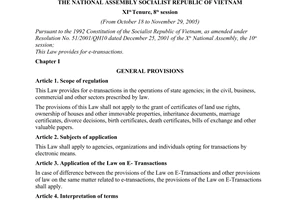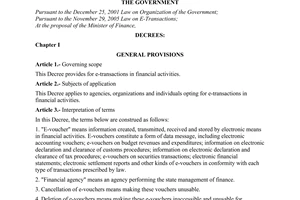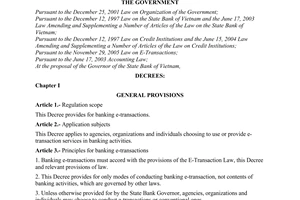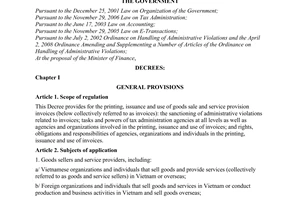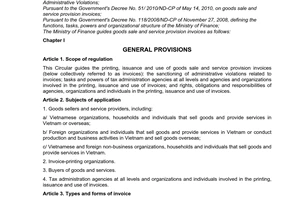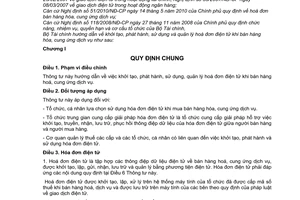Nội dung toàn văn Circular No. 32/2011/TT-BTC guiding the creation, issuance and use of e-invoice
|
THE
MINISTRY OF FINANCE |
SOCIALIST
REPUBLIC OF VIET NAM |
|
No. 32/2011/TT-BTC |
Hanoi, March 14, 2011 |
CIRCULAR
GUIDING THE CREATION, ISSUANCE AND USE OF E-INVOICES FOR GOODS SALE AND SERVICE PROVISION
Pursuant to the November 29.
2006 Tax Administration Law:
Pursuant to the June 17, 2003 Accounting Law and guiding documents;
Pursuant to the November 29. 2005 E-Transaction Law. Decree No. 27/2007/ND-CP
of February 23. 2007, on e-transactions in financial operations, and Decree No.
35/2007/ ND-CP of March 8, 2007. on e-transactions in banking operations;
Pursuant to the Government's Decree No. 51/ 20I0/ND-CP of May 14, 2010, on
goods sale and service provision invoices;
Pursuant to the Government's Decree No. 118/2008/ND-CP of November 27. 2008.
defining the functions, tasks, powers and organizational structure of the
Ministry of Finance.
The Ministry of Finance guides the creation, issuance, use and management of
e-invoices for goods sale and service provision as follows;
Chapter I
GENERAL PROVISIONS
Article 1. Scope of regulation
This Circular guides the creation, issuance, use and management of e-invoices for goods sale and service provision.
Article 2. Subjects of application This Circular applies to:
- Users of e-invoices for goods sale and service provision.
- Intermediary e-invoice solution providers, which are providers of solutions for the creation, transmission, receipt, storage and recovery of data messages of e-invoices between goods sellers and buyers.
- Tax administrations of all levels and organizations and individuals involved in the creation, issuance and use of e-invoices.
Article 3. E-invoices
1. E-invoice is a compilation of e-data messages on goods sale or service provision, which is created, billed, sent, received, stored and managed electronically. An e-invoice must meet the requirements specified in Article 6 of this Circular.
E-invoices shall be created, billed and processed in the computer system of an organization having a tax identification number upon sale of goods or provision of services and stored in computers of involved parties under the law on e-transactions.
E-invoices include export invoices; value-added invoices; sale invoices; other invoices including stamps, tickets, cards, insurance premium receipts; air freight receipts. international freight vouchers, banking service charge vouchers, etc. The forms and contents of these invoices comply with international practice and relevant laws.
An e-invoice must enable the identification of its serial number on the principle of consecutiveness and in sequential lime and must be billed and used only once for each invoice number.
2. Invoices which are billed in paper but processed, transmitted or stored in e-devices are not e-invoices,
3. An e-invoice is legally valid when it fully satisfies the following conditions:
a/ Reliability for the integrity of information contained in the e-invoice is assured.
Criteria for information integrity evaluation are completeness and intactness except changes in appearance arising in the exchange, storage or display of an e-invoice.
b/ Information contained in an e-invoice can be accessed and used in complete form when necessary.
Article 4. Use principles and conditions on e-invoice creators
1. Principles of e-invoice use
A seller that chooses to use e-invoices for goods sale or service provision shall notify a buyer of the format of its e-invoices. the mode of transmission and receipt of e-invoices between the seller and buyer (specifically direct transmission from the seller's system to the buyer's or billing and transmission to the buyer through the intermediary system of the e-invoice solution provider).
The seller, buyer, intermediary e-invoice solution provider (if any) and concerned units shall reach agreement on technical requirements and conditions for assurance of integrity and confidentiality for e-invoices.
2. Conditions on invoice creators
A goods seller or service provider (below collectively referred to as seller) which creates e-invoices must satisfy the following conditions:
a/ Being an economic organization which satisfies the conditions on and is making e-declarations of taxes with a tax office; or being an economic organization conducting e-banking transactions;
b/ Having a place and lines for information transmission and communication networks and transmission devices meeting requirements on exploitation, control, processing, use. preservation and storage of e-invoices;
c/ Having qualified and capable personnel for creating, billing and using e-invoices under regulations;
d/ Having e-signature under law ;
e/ Having goods sale or service provision software linked with the accounting software. enabling automatic transfer of data of e-invoices for goods sale or service provision to the accounting software (or database) at the lime of billing invoices;
f/ Having processes for backup, recovery and storage of data, which meet essential requirements on storage quality, including:
- The data storage system meets or is proven to be compatible with standards on data storage systems;
- The process for data backup and recovery upon system breakdown is available, which enables backup of e-invoice data in storage media or server cache.
Article 5. Conditions on intermediary e-invoice solution providers
An intermediary e-invoice solution provider must satisfy the following conditions:
- Being an enterprise operating in Vietnam. possessing a business registration certificate or investment certificate or investment license for operation in information technology or being a bank licensed to provide e-banking services.
- Having a software for creating, billing, transmitting and receiving e invoices, which ensures that billed e-invoices meet all the requirements specified in Article 6 of this Circular.
- Having operated information technology solution provision systems to serve e-data exchange between enterprises or between organizations.
- Having equipment and technical systems ensuring provision of e-invoice solutions meeting business requirements and complying with the law on invoice issuance.
- Being capable of detecting, warning and preventing illegal access and attacks in the network environment to guarantee confidentiality and integrity of data exchanged between involved parties.
- Having and implementing processes for data backup, online data backup and data recovery; having preventive measures for remedying data recovery-related incidents
- Having solutions for storage of transmission results between involved parties; storing e-data messages of e-invoices in the system.
- Biannually submitting a report to the tax office (made according to a form provided in the Appendix to this Circular, not printed herein) which specifies a list of enterprises using its e-invoice solutions (including both sellers and buyers) and the quantity of used invoices (including invoice type, symbol, pattern symbol and serial number).
Article 6. Contents of e-invoices
1. An e-invoice must contain the following details:
a/ Name, symbol, pattern symbol and serial number of the invoice;
The symbol, pattern symbol and serial number of an invoice comply with Appendix No. 1 to the Finance Ministry's Circular No. 153/2010/TT-BTC.
b/ Name, address and tax identification number of the seller:
c/ Name, address and tax identification number of the buyer;
d/ Name of goods or service; unit of calculation, quantity, unit price and amount in figures and words.
In addition to the line of unit price, which is value-added tax exclusive, a value-added tax invoice must contain lines of value-added tax rate, value-added tax amount and total paid amount in figures and words.
e/ Lawful e-signature of the seller; date of billing and sending the invoice. Law full e-signature of the buyer, in case the buyer is an accounting unit.
f/ The invoice is written in Vietnamese. For an invoice requiring foreign language words, those words shall be put in brackets ( ) to the right of or just below the Vietnamese words with a font size smaller than that of the Vietnamese words. Figures written on an invoice are natural numbers: 0. 1. 2. 3. 4. 5. 6. 7. 8 and 9. The digit representing thousands, millions, billions, trillions, million billions and billion billions must be followed by a dot (.). The digit after the digit representing units must be preceded with a comma (.). When there is no specific agreement between the buyer and seller on the language used in an c-invoice for export of goods or services, the e-invoice (export invoice) shall be written in English.
If using comma (.) after the digit representing thousands, millions, billions, trillions, million billions and billion billions and the dot (.) after the digit representing units, an e-invoice creator shall notify such in its notice of e-invoice issuance.
The details specified at Points b. c and d. Clause 1 of this Article must precisely show the nature and characteristics of the business line, arising economic activities, collected amounts, the buyer (or payer, service recipient, etc.). the seller for service provider, etc.). name of goods or service or payment content.
2. E-invoices which are not required to contain all compulsory contents comply with separate guidance of the Ministry of Finance.
Chapter II
CREATION. ISSUANCE AND USE OF E-INVOICES
Article 7. Creation and issuance of c-invoices
1. Creation of an e-invoice means creating prior to goods sale or service provision the invoice format with complete information on the seller, the invoice type and symbol and the default for e-invoice transmission, receipt and storage in electronic devices of a business or an e-invoice service provider, which are stored in electronic devices of involved parties under law.
Before creating e-invoices, an organization shall issue a decision on application of e-invoices (made according to a form provided in the Appendix to this Circular, not printed herein ) and send it to its managing tax office in hard copy or electronically through the tax office's website and lake responsibility for this decision.
A decision on application of e-invoices contains the following principal contents:
- Name of the equipment system (names of electronic devices), name of the application software for creating and billing e-invoices.
Electronic device means a device operating based on the electric, electronic, digital. magnetic, wireless transmission, optical, electromagnetic or analog technology.
- Technical section or name of the service provider responsible for technical issues related to e-invoices and the application software;
- Processes for creating, billing, transferring and storing e-invoice data within the organization.
- Responsibilities of each section involved in the creation, billing, processing, transfer and storage of e-invoice data within the organization. including responsibilities of persons converting e-invoices into paper ones.
2. Issuance of e-invoices
Before using e-invoices. an e-invoice creator shall make an e-invoice issuance notice and send it to its managing tax office. Such notice (made according to a form provided in the Appendix to this Circular, not printed herein) contains the name, tax identification number, address and telephone number of the e-invoice issuer, types of invoices to be issued (name of invoice type, invoice symbol, symbol of invoice pattern number, date of first use. quantity of invoices to be issued (from number ... to number)), date of the notice; name and signature of the representative at law and seal of the unit (when the notice is sent to the tax office in hard copy); or e-signature of the issuer (when the notice is sent to the tax office electronically through the tax office's website).
When changing its business address, an e-invoice creator shall send the invoice issuance notice to the tax office of the locality to which it moves, specifying the quantity of issued invoices which have not been used and will be used.
When there are changes in contents of an issuance notice, the e-invoice creator shall make a new issuance notice under this Clause.
The e-invoice creator shall give its e-signature in the specimen e-invoice and electronically send it (in the format to be sent to the buyer) to the tax office.
The e-invoice issuance notice (excluding the specimen e-invoice) shall be posted up at the head office of the e-invoice creator or published in its website throughout the use of e-invoices.
3. A business may concurrently create different forms of invoices (self-printed invoices, invoices printed on order, e-invoices) and shall make an issuance notice for each form of invoices under regulations.
For each time of selling goods or providing services, a business may use only one (1) form of invoices. Specifically, if it uses a self-printed invoice for sale of goods or provision of services, it may not use an invoice printed on order or an e-invoice for such sale or provision. If it uses an e-invoice, it may not use a self-printed invoice or an invoice printed on order. If it uses an invoice printed on order, it may not use an e-invoice or a self-printed invoice.
Article 8. Billing e-invoices
1. Billing an e-invoice means the establishment of all information specified in Article 6 of this Circular in a specific invoice format when selling goods or providing services. Forms of hilling an e-invoice:
- The seller (e-invoice creator) bills the e-invoice in its e-invoicing software;
- The seller (e-invoice creator) accesses to the e-invoicing system program of an intermediary e-invoice solution provider to create and bill the e-invoice.
2. Sending an e-invoice means the transmission of invoice data from the goods or service seller to the buyer.
Forms of sending an e-invoice:
- Directly: The seller (e-invoice creator) bills the e-invoice in its e-invoicing software, gives its e-signature in the invoice and directly transmits it to the buyer's system by the mode agreed between the two parties. When the buyer is an accounting unit, it gives its e-signature in the received e-invoice and transmits the e-invoice with e-signatures of both parties to the seller by the mode agreed between them.
- Through an intermediary e-invoice solution provider:
The seller (e-invoice creator) accesses the e-invoicing system program of the intermediary e-invoice solution provider to create and bill the e-invoice in this program or inputs the e-invoice data created in the seller's internal system in the intermediary e-invoice solution provider's system for sending the e-invoice with the seller's e-signature to the buyer through the provider's system. When receiving the e-invoice with the seller's e-signature. a buyer being an accounting unit gives its e-signature in this invoice and sends the invoice with e-signatures of both parties to (he seller through the intermediary e-invoice solution provider's system.
Article 9. Handling of billed e-invoices
1. When detecting errors in an e-invoice which has been billed and sent to the buyer, but the goods or service has not been delivered or the seller and buyer have not declared taxes, such e-invoice may be voided only with consent and certification of the seller and buyer. An e-invoice shall be voided according to the time agreed by involved parties. Voided e-invoices shall be stored for competent state agencies' reference.
The seller shall bill a new e-invoice under this Circular to be sent to the buyer. The new e-invoice must contain the phrase "this invoice replaces invoice number.... symbol .... sent on date... .
2. When detecting errors in an e-invoice which has been billed and sent to the buyer and the goods or service has been delivered and the seller and buyer have declared taxes, the seller and buyer shall make a written agreement with their e-signatures, clearly indicating the error, and the seller shall concurrently bill an e-invoice correcting those errors. This e-invoice must specify the increase or decrease in goods quantity, sale price, value-added tax rate and value-added tax amount from e-invoice number..., symbol... Based on this e-invoice. the seller and buyer shall make modified declarations under current laws on tax administration and invoices. A modifying invoice must not contain negative (-) figures.
Article 10. Reporting on use and authorized billing of e-invoices
Reporting on use and authorized billing of e-invoices comply with the Finance Ministry's Circular No. 153/2010/TT-BTC of September 28. 2010. E-invoice creators may submit reports on use of e-invoices electronically through websites of tax offices.
Article 11. Storage, voiding and destruction of e-invoices
1. Goods or service sellers and buyers that use e-invoices for recording in accounting books and making financial statements shall store e-invoices for a duration prescribed in the Accounting Law. E-invoices which are created from the system of an intermediary e-invoice solution provider shall be stored for a duration prescribed above by such provider.
Sellers and buyers being accounting units and intermediary e-invoice solution providers shall backup e-invoice data in storage media (such as USB flash drive. CD. DVD; external haul disk drive, internal hard disk drive) or online to protect e-invoice data.
2. A billed e-invoice shall be stored in the form of data message and must satisfy the following conditions:
a/ Its contents arc accessible and usable for reference when necessary:
b/ Its contents are stored in the format in which it has been created, sent, received or in the format which allows precise presentation of its contents;
c/ It is stored by a mode which allows tracing of its creation origin, destination, date and time of sending or receiving the e-invoice.
3. Voiding an c-invoice means invalidating such invoice.
Destroying an e-invoice means making such invoice inaccessible and its information not referable.
E-invoices for which the storage duration terminates under the Accounting Law may be destroyed unless otherwise decided by competent slate agencies. Destruction of e-invoices must not harm the integrity of undestroyed e-invoices and must ensure normal operations of the communication system. E-invoices shall be destroyed according to the invoice destruction procedures provided in the Government's Decree No. 51/2010/ND-CP and the Finance Ministry's Circular No. 153/2010/TT-BTC.
When a seller or buyer loses an e-invoice. it may request the buyer or seller or an involved part) that still stores such e-invoice in the form of data message to re-send the e-invoice.
When a seller or buyer loses an e-invoice and is unable to contact involved parties for re-sending such invoice, it shall report on invoice loss under the Finance Ministry's Circular No. 153/2010/TT-BTC.
Article 12. Conversion of e-invoices into paper ones
1. Conversion principles
A goods seller may convert e-invoices into paper ones to prove the origin of tangible goods in their circulation but for only once. An e-invoice converted into a paper one to prove goods origin must meet the requirements specified in Clauses 2. 3 and 4 of this Article and contain the signatures of the representative at law and seal of the seller.
Buyers and sellers may convert e-invoices into paper ones for storage of accounting documents under the Accounting Law. which must meet the requirements specified in Clauses 2. 3 and 4 of this Article.
2. Conditions
An e-invoice converted into a paper one must fully satisfy the following conditions:
a/ Fully presenting contents of the original e-invoice;
b/ Having a particular sign showing that it is converted from the e-invoice;
c/ Having the signature and full name of the person converting it from the e-invoice.
3. Legal validity of converted e-invoices A converted e-invoice has the legal validity when meeting the requirements on integrity of information of the original invoice, having particular sign proving such conversion and signature and full name of the person making conversion under the law on conversion of e-documents.
4. Particular signs of converted invoices
The particular sign of a paper invoice converted from an e-invoice must fully contain the following information: the phrase distinguishing between the converted invoice and the original e-invoice-source invoice (clearly stating "invoice converted from e-invoice"); full name and signature of the person making conversion; and lime of conversion.
Article 13. Inspection of the creation, billing, issuance, management and use of e-invoices
1. Competent state agencies shall inspect, examine, detect and handle violations of regulations on e-invoices in the sale of goods and provision of services.
2. Users of e-invoices for goods sale or service provision are subject to inspection and examination and shall fully provide e-invoice data, e-invoice storage media and other documents to competent state agencies under law.
Inspection and examination of users of e-invoices for goods sale and service provision comply with law.
The sealing, custody and confiscation of e-devices for e-invoice creation comply with the Government's Decree No. 27/2007/ND-CP of February 23. 2007.
Chapter III
ORGANIZATION OF IMPLEMENTATION
Article 14. Effect and organization of implementation
1. This Circular lakes effect on May 1, 2011,
2. Contents other than those guided in this Circular shall be implemented under the Government's Decree No. 51/2010/ND-CP of May 14. 2010. and the finance Ministry's Circular No. 153/2010/TT-BTC of September 28. 2010.
Any problems arising in the course of implementation should be promptly reported lo the Ministry of finance for guidance and settlement./
|
|
FOR
THE MINISTER OF FINANCE |

